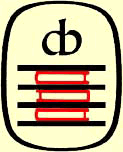Genealogies, Biographies, Memoirs
A genealogy, biography, or memoir may be bound in a simple and relatively inexpensive manner. Or it can be a complex project with the added costs that are associated with the extra time and special handling of more involved bindings.
"Glimpses"(right) is a midrange binding with some finishing touches that provide the book with a cultivated, professional look. The use of a stamping die for the front cover and spine titling acts as visual tie-in to the interior layout. In this case "Glimpses" was created by a professional book designer who arranged the photos and text with chapter headings to create a book that is not just visually appealing but is easily read as well.
"Turning the Leaves"(left) and "Our Story"(below) are examples of bindings that make use of a number of additional features. These extra touches not only make the books better resources, they also add to the cost of the binding.
Any basic binding would include page attachment, trimming of the text block - when possible, and stamping or titling on the cover. Stamping costs can vary depending on the amount of stamping being done and its placement. The stamping or titling that is covered in a basic binding is a brief title and author using our in-house typeface, Optima. Basic stamping is usually on either on the spine or front cover. Stamping can be on both the spine and the front cover for an additional cost.
Stamping dies let the customer choose a specific typeface and layout for cover stamping. In the case of "Our Story" it allowed for a family crest on the front cover. Not all designs work well with hot foil stamping. It's best to have all designs pre-approved.
Another distinction these two sets have is the three-piece cover. While this produces the effect of a more cultivated set of books, from a manufacturing point of view it also adds to both the material cost and the labor time.











